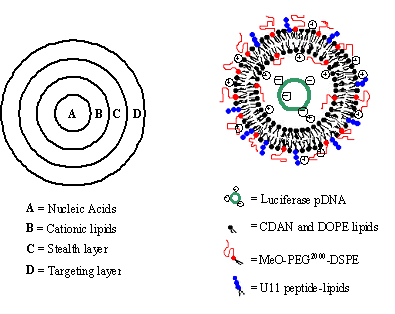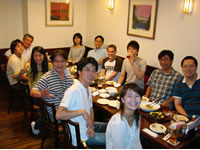JSPS Fellow's Experiences in Japan
Dr. Ming Wang (Imperial College London)
JSPS Summer Programme
Host Institution: National Cancer Center, Tokyo
(June 2008- August 2008)
Research institute: Section for Studies on Metastasis, National Cancer Centre, Tokyo, Japan.
Host researcher: Dr.Takahiro Ochiya.
Current contact details: Department of Chemistry, Imperial College London, London, UK.
Email: ming.wang05@imperial.ac.uk
Here in London, our work is concerned with the engineering and assembly of nano-sized vehicles used for drug delivery into cancer cells. Following recognised understanding of tumour biology and pharmacokinetics, we apply chemical and engineering methods to determine a list of advantageous characteristics of which enhance the delivery ability of nanoparticles into tumours. We use the eABCD nomenclature to describe the components of a nanoparticle, where each letter represents a layer within the system required to render favourable characteristics for delivery (Figure 1). The eA core represents the drug or the therapeutic nucleic acid cargo, which requires physical protection in the form of the eB layer, which consists of cationic lipids. The eC layer is a further protection layer, consisting of biocompatible polymer chains, shielding the eAB core from serum proteins, and sustaining colloidal stability of the nanoparticles in biological fluids. Finally, the eD layer is the surface layer comprising receptor-specific ligands, which on inclusion, renders cell-specificity to the assembled nanoparticles.
My main interest is in the organisation of the ligands on the surface of these nanoparticles (D layer) for maximising cell specificity. Our ligand is a peptide based ligand which has high affinity for the urokinase plasminogen activator receptor (uPAR), a receptor found to be overexpressed on a variety of cancer cells. We have found that the ligand density, as well as the spatial extension of the ligand plays important roles in enhancing the ligand targeting effect. On applying the ligands at an optimised organisation onto the surface of an eABC platform, we showed that the assembled ABCD system had favourable characteristics for gene delivery into cancer cells.
Our collaboration with Dr Ochiya lab at the National Cancer Centre (Section on studies for metastasis) in Tokyo, Japan, allowed us to investigate the effect on functional gene delivery by our targeted ABCD systems in biological models. Firstly, we characterised the expression levels of uPAR, in a range of luciferase-expressing cancer cells by real-time PCR. We identified the metastatic breast cancer cell line, MM231-luc to express uPAR levels at 30-fold higher than non-uPAR-expressing controls, making it a suitable cell line with which to identify the receptor-targeting ability of uPAR-targeted ABCD nanoparticles.
This was followed by the encapsulation of short interference RNA (siRNA) molecules into the A core of the ABCD nanoparticles and then their administration into MM231-luc in vivo models. We found that the ABCD nanoparticles were able to specifically deliver and functionally knock-down the luciferase protein in MM231-luc cancer cells, as the ABC non-targeted counterparts had no effect on luciferase protein expression. We can therefore conclude that the ABCD nanoparticles can be delivered through site-specificity. Following the proof-of-concept, we aim to continue in the field of nanoparticle drug delivery by assessing the toxicology of these ABCD delivery systems.

presentation of the ABCD fnanoparticles for drug and gene delivery.






